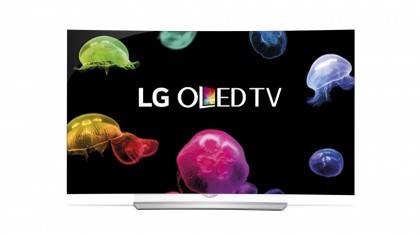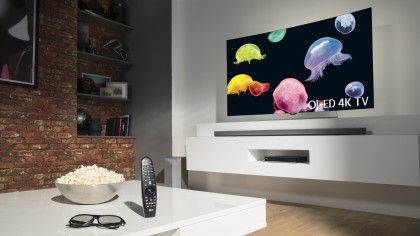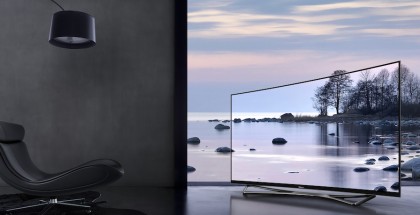OLED TV: what you need to know
We're not exaggerating when we say that OLED is most likely the future of television displays. The premium screen technology is still expensive, but is seeing wider implementation and improvement all the time, even becoming the new display of choice for the iPhone X and its newly announced successors: the Phone XS and iPhone XS Max.
But what is OLED? Standing for 'Organic Light Emitting Diode', the acronym describes a type of panel that TVs use – like LED-LCD, plasma or CRT. It's different from the other types of panels that have come before it, but the overarching idea is exactly the same: OLED panels help bring images and video to life in front of your eyes.
In short: OLED truly is the next big thing in home entertainment and it's finally reaching a price point within reach of regular consumers. It offers better image quality (think blacker blacks and brighter whites), reduced power consumption, and faster response times over traditional LED TVs.
So why doesn't everyone own one? Right now, they're still prohibitively expensive and for years only a handful of companies used the technology in their TVs.
But that's changing. Sony, one of the initial developers of the technology got back in the game in 2017 with its new Bravia A1E OLED and Sony A8F OLED TV. Philips has threw its hat into the ring with this year's Philips OLED 803 and OLED+ 903; Panasonic has done the same with its FZ952/FZ950 OLED and LG has carried the torch for the last five years with its B-, C-, G-, E- and W-Series OLED TVs.
So is OLED worth the hype? We've run you through everything you need to know about latest big screen buzzword in the article below.
[Update: Looking for the latest OLED TVs? Sony has just announced that it will release an A9F OLED later this year. The A9F will not only raise the image quality bar thanks to Sony’s new X1 Ultimate chipset, but it will sound better than its predecessor too thanks to an upgraded Acoustic Surface audio system. Pricing will start at $3,499 for the 55-inch XBR-55A9F (£2,999) and shoot up to $4,499 (£3,999) for the 65-inch XBR-65A9F.]

What's the difference between OLED and LCD/LED?
Everything. They might sound alike, but the processes are completely different.
OLED stands for Organic Light-Emitting Diode, with "organic" referring to the carbon film that sits inside the panel before the glass screen.
OLED panels emit their own light when an electric current is passed through, whereas cells in a LCD display require an external light source, like a giant backlight, for brightness.
This backlight is what separated LCD screens from their LED variants. A traditional LCD screen has a backlight (called a cold-cathode fluorescent light, or CCFL) which is uniform across the entire back of the screen.
This means that whether the image is black or white, it is being lit by exactly the same brightness across the panel. This reduces what we call "hotspots," or areas of super bright light, because the actual light source illuminating them is uniform.
This all started a few years back when engineers at companies like Samsung and Sony introduced an array of LEDs as a backlight, which meant that if a certain part of the screen was black then those LEDs behind that portion could be turned off to make it appear blacker.

This is a better solution than a CCFL backlight, but it still has its problems. Since it's a light behind the LCD producing the illumination rather than the LCD layer itself, the illumination is not entirely in-sync with the pixel in front of it. The result is an effect called 'blooming', whereby LED light from bright portions of the image bleeds over into areas of blackness.
This is what separates OLEDs from LCD/LED displays. In an OLED display, the pixels themselves are the things producing the light, and so when they need to be black they are able to turn off completely, rather than relying on a backlight to turn off on their behalf.
What are the advantages of OLED?
The result is remarkably dark blacks in an image, and when you combine this with the brightness of the whites an OLED panel is able to produce you're left with a fantastically vibrant image.
LG and Panasonic, pretty much the most consistent producers of OLED televisions on the planet, like to use the term "infinite contrast" to describe how the self-lighting pixels switch off completely when reproducing black giving it an "absolute" black color instead of a "relative" black that only describes how dark one pixel can get compared to the brightest pixel on the screen.

For years there was a question mark about longevity of OLED panels, while production lines have been impossible to make profitable due to high failure rates. But as companies like LG have invested huge quantities of money in the technology – with the likes of Philips and Sony joining the fray – its affordability has gotten better, although it's still much more expensive than competing technologies.
The advantages of OLED go beyond simple static image quality to the responsiveness and smoothness of the display itself, meaning gamers and home cinema aficionados are going to absolutely love OLED. It's capable of a refresh rate of as low as 0.001ms, which for reference, is around 1,000 times faster than a standard LED-backlit LCD panel, while also being superior to the now-discontinued plasma tech, too.
And, because the lighting source they use is so tiny, the depth of screen sizes has shrunk at the same rate. That means OLED TVs have awesomely deep blacks and bright, peak whites, improved color accuracy as well as smooth responsive motion - and all from a form factor that's just a few millimetres in depth and much lighter than standard TVs.
Which OLED TVs are out now?
OLED TVs have been on the market since 2012, and a variety of manufacturers have tackled the technology over the years. It used to be the case that OLED's were produced by just Samsung and LG, but Samsung dropped the technology over its cost and how difficult it was to produce, and has no intention of restarting production any time soon.
LG, on the other hand, has been releasing OLED sets consistently over the last few years, and in 2016 introduced four easy-to-understand product lines – the G6, E6, C6 and B6 – featuring OLED panels. In 2017, LG continued with the 7-Series TVs, and now, in 2018, has worked its way up to the 8-Series of TVs: the B8, C8, E8, G8 and ultra-thin LG Signature W8 OLED.
If you're not big into LG TVs, Sony also offers two OLED TVs: the Sony Bravia A1E OLED from 2017 and the new Sony Bravia A8F and A9F for 2018. Panasonic brought out its first OLED set, the TX-65CZ950, last year, and Philips impressed with its new pair of OLED 803 and OLED+ 903 televisions out in late 2018.
How much do OLED TVs cost?
OLED TVs are definitely getting cheaper, but they're still a long way from what we'd call affordable. The prices of LGs sets start at $1,700 in the US and £1,300 in the UK, and Panasonic's are more expensive still.
The scarcity of OLED TVs on the market means that those small number of players in the market are more or less free to charge exactly what they want. We're not going to see prices drop until we get more competition.
That said, usually when one company starts to pull ahead, the others quickly catch up. Prices should come down when manufacturers can work out the kinks on the production line and demand increases for these phenomenal pieces of tech.
What's the future for OLED?
OLED is an expensive new technology that even after several years is still proving difficult for manufacturers to get right.
In fact, OLED has been around for so long without having made it to the masses that in 2014 we wrote an opinion piece about how the technology might be dead.

Obviously the fact that we're still talking about OLED in 2017 means that the technology is far from dead, but after so many years of trying to make it work it's difficult to maintain hope that it will ever be truly affordable.
But just because OLED isn't affordable yet doesn't mean it's not getting better. An $1,700 / £1,300 price tag isn't what we'd consider budget, but it's a great deal cheaper than what OLED was retailing for even just a year ago.
If this trend continues we might just see the technology become mainstream in a couple of years time, but for now OLED remains something for enthusiasts.
Original reporting in this article was by Jamie Carter.
- Convinced? Head to our round-up of the best OLED TVs you can buy right now
Contributer : Techradar - All the latest technology news https://ift.tt/V8NOsO

 Reviewed by mimisabreena
on
Wednesday, September 26, 2018
Rating:
Reviewed by mimisabreena
on
Wednesday, September 26, 2018
Rating:














No comments:
Post a Comment